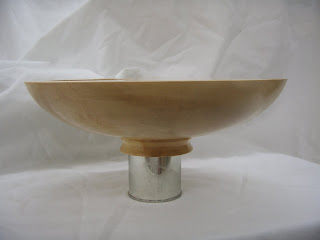Having just finished a make over of our downstairs cloakroom, we were in need of a loo roll holder & as I`d used oak for the fit out i decided I`d carry on the theme by turning an Oak holder.
First off the cloakroom so far.
To get the holder started i fixed an 80mm blank on a screw mount, this was then held in pin jaws & turned round & sanded.
This was set to one side & a 45mm square piece of stock mounted between centers & the front bar of the holder turned.
I left the ends square & didn`t go to thin where the bar would be later parted off from the scrap as i needed some strength as the next job was to drill a hole for the piece that would join the bar to the back plate at the pillar drill.
.
First an 18mm hole was drilled so the connecting bar would sit on a flat surface, then the bar was turned over & a 12mm hole drilled all the way through.
The next job was to make the connecting bar, it needed to be 18mm round with two 12mm tenons on the ends.
With the connecting bar ready the ends were trimmed off the main bar, a + slot cut in the end of one tenon, glue applied & the two bars joined together. In all the excitement i didn`t photo this & only have a picture of the finished tenon being cleaned up with a sharp chisel.
To make up for missing the cutting of the tenon, gluing & wedging, I photo`d the other end being jointed into the back plate.
Whilst the glue was going off i turned my attention to a blank i`d glued up first thing.
The blank consisted of a veneer of Blackwood sandwiched between 2 pieces of Oak from which I turned these two screw covers.
Back to the holder, the tenon was cleaned up & given a good sanding, then back to the pillar drill & the fixing holes bored.
The finished holder, complete with screw covers, though I'm not sure if i like them, they may be replaced with plain ones once oiled & fitted.
I`ll add a photo of the holder fixed in position once oiled.

















































